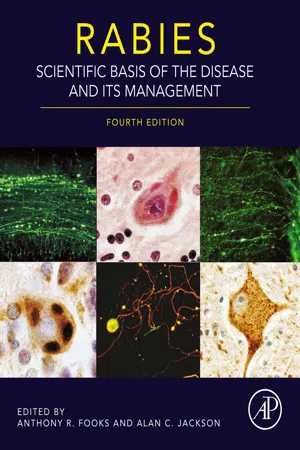
Rabies
Scientific Basis of the Disease and Its Management
- 732 pages
- English
- ePUB (mobile friendly)
- Available on iOS & Android
About this book
Rabies: Basis of the Disease and Its Management, Fourth Edition is an authoritative reference on the current status of rabies, including the virological, clinical, and public health aspects and management recommendations. Rabies remains one of the most important global public health problems worldwide. Although many important developments have been made over the past century to combat this disease, rabies has become a re-emergent infection in the resource-constrained countries. The Fourth Edition updates this classic reference with comprehensive coverage of the molecular virology, pathogenesis, immunology, vaccines, public health aspects, and epidemiology of rabies and is completely revised, with new chapters that will cover historical developments in rabies intervention strategies, the evolution of rabies virus, modeling rabies control, and on the strategy for rabies elimination. Rabies, Fourth Edition, provides physicians, veterinarians, public health advisors, epidemiologists, and research scientists with a single source for authoritative and up-to-date information on the diagnosis, treatment, control, and prevention of this fatal infectious virus.- Edited by renowned researchers in this subject and has gathered a team of experts to detail the science, treatment, and control of rabies- Completely revised, the Fourth Edition presents rabies as a re-emergent infection with emphasis on a global perspective of the disease- Includes new chapters the evolution of the rabies virus and on modeling rabies control and includes many full-color figures that highlight important information
Frequently asked questions
- Essential is ideal for learners and professionals who enjoy exploring a wide range of subjects. Access the Essential Library with 800,000+ trusted titles and best-sellers across business, personal growth, and the humanities. Includes unlimited reading time and Standard Read Aloud voice.
- Complete: Perfect for advanced learners and researchers needing full, unrestricted access. Unlock 1.4M+ books across hundreds of subjects, including academic and specialized titles. The Complete Plan also includes advanced features like Premium Read Aloud and Research Assistant.
Please note we cannot support devices running on iOS 13 and Android 7 or earlier. Learn more about using the app.
Information
A history of rabies—The foundation for global canine rabies elimination
b Institute of Molecular Virology and Cell Biology, Friedrich-Loeffler-Institut, Federal Research Institute for Animal Health, Greifswald-Insel Riems, Germany
c Department of Neurovirology, National Institute of Mental Health & Neurosciences, Bangalore, India
d Pablo Cassara Foundation, Buenos Aires, Argentina
e Onderstepoort Veterinary Institute, Pretoria, South Africa
f The University of Sydney, Camden, Australia
Abstract
Keywords
1.1 Introduction
1.2 Asia
1.2.1 A seat of canine domestication?
Table of contents
- Cover image
- Title page
- Table of Contents
- Copyright
- Contributors
- Foreword
- Preface
- Chapter 1: A history of rabies—The foundation for global canine rabies elimination
- Chapter 2: Rabies virus
- Chapter 3: Evolution of rabies virus
- Chapter 4: Epidemiology
- Chapter 5: Molecular epidemiology
- Chapter 6: Rabies in terrestrial animals
- Chapter 7: Bat rabies
- Chapter 8: Human disease
- Chapter 9: Pathogenesis
- Chapter 10: Pathology
- Chapter 11: Immunology
- Chapter 12: Laboratory diagnosis of rabies
- Chapter 13: Measures of rabies immunity
- Chapter 14: Human and animal vaccines
- Chapter 15: Next generation of rabies vaccines
- Chapter 16: Public health management of humans at risk
- Chapter 17: Therapy of human rabies
- Chapter 18: Dog rabies and its control
- Chapter 19: Rabies control in wild carnivores
- Chapter 20: Modeling canine rabies virus transmission dynamics
- Chapter 21: Strategies for the elimination of dog-mediated human rabies by 2030
- Chapter 22: Future developments and challenges
- Index